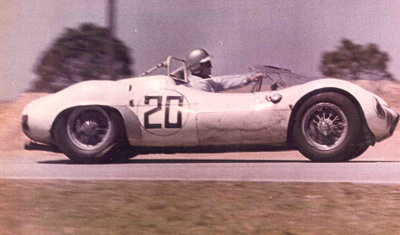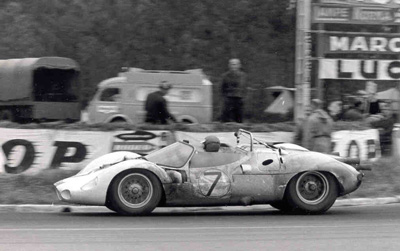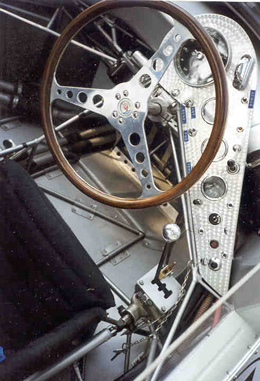February 4th, 2004
One Car, Three Numbers
Excerpts from "Birdcage to Supercage"
Willem Oosthoek first laid eyes on a rear-engined Birdcage when he was eighteen, while still living in Holland. "My dad was shopping for a second hand Alfa Romeo at Maasland, the importer in The Hague. In the back of their garage was chassis 63.006, the former Camoradi car and it was love at first sight. I could not convince my dad that the Tipo 63 was a much more practical family car and am still bearing the scars of that traumatic experience!"
Such is the making of an automotive historian.
Forty years later Oosthoek is still enamored by these ultra rare Maseratis,
and has devoted over fifteen years (on and off) to research. Much of what he has found appears in his book (his first), entitled "Birdcage to Supercage".
One particular Maserati, serial number 63.002, proved to be a car with three histories. Or was it a number with three cars....
Below, using excerpts from his new book, is the story as related by Oosthoek. *
The first rear-engined design in Maserati�s history made its initial appearance on December 15th 1960 at the test track at Modena.
Its engine compartment contained the standard 4 cylinder Tipo 61 engine of
2890cc. Since the designation Tipo 62 had already been assigned to a
V-8 marine engine, it was called the Tipo 63.

Sebring, 1961. In its original guise, 63.002 resembled the factory "mule", with a short nose and long windscreen.
|
By early February 1961, the factory felt comfortable enough to start an initial production run of three Tipo 63 cars. These first three cars were
ordered by Briggs Cunningham (chassis 63.002), Count Giovanni Volpi of Scuderia Serenissima (chassis 63.004) and Lucky Casner of Camoradi USA (chassis 63.006).
At Sebring on March 25th, the Cunningham car, assigned to veteran Walt Hansgen and newly hired Bruce McLaren, occupied 3rd and 4th places during the first six hours until it developed a cracked transaxle housing. On the weekend of April 8-9th, the organizers of the Le Mans 24 Hours opened the track to allow practice sessions for the entries of the June 10-11 endurance race. As part of a contingent of three Tipo 63s brought by the factory, chassis 63.002 was tested by Walt Hansgen.

After the accident at the Le Mans trials in April, 63.002 was completely rebuilt and now featured the V12.
|
At the approach to Indianapolis, the rear suspension collapsed and Walt was lucky to escape unharmed, but chassis 63.002 suffered severe damage. Ing. Alfieri ordered all the cars to be shipped back to Modena. By June 10th, Cunningham was back at Le Mans with two rear-engined Birdcages, a refurbished 63.002 and a new, longer wheelbased 63.010. This would be the first of two LWBs ordered by Cunningham.

If the body wasn't striking enough, the cockpit of 63.002 was enough to garner much attention.
|
The Sebring car which had crashed so heavily at Le Mans
was barely recognizable as it had been completely redesigned. Both 63s were now equipped with the 310 hp V12 engines, although slightly different from each other. The Sebring car, which formerly had a short front nose and a long, sloping windshield, now featured a long nose and a traditional glass windshield straight off the Alfa Romeo Sprint Speciale production line.
In the hands of Dr. Dick Thompson and Augie Pabst, 63.002 was at the back of the pack after refusing to start, but Thompson drove aggressively and within an hour was up to 10th. But later in the race, a number of 20+ minute pit stops to change plugs threw the Tipo 63 back down in the standings. Remarkably the car survived the grind and in the end Thompson and Pabst took it to a fourth place finish, a record for a Maserati in a 24 hour event.
After the race, it was decided that the long wheelbase version was a better fit for both the drivers and the V12. Cunningham then ordered a second LWB Birdcage, which used the engine from 63.002. The famous SWB Le Mans car was now consigned to the factory scrap heap of obsolete racecars.
In the early 1990s, 63.002, still resting in the factory scrap heap, was purchased by the Artom brothers of Milano, and went through a complete rebuild lasting almost four years.

A case of factory-instigated mis-identity, 63.002LWB is the second LWB rear-engined car ordered by Cunningham.
|
During the last decade, two more Maseratis have surfaced with claims of being the 4th place Le Mans car of 1961 vintage. Both have 63.002 chassis plates, but both are distinctly different from the real 1961 Le Mans finisher.
Edmond Pery bought a V12 Tipo 63 in the U.S. in the 1980s and restored it. Since then the car had changed ownership a number of times, its current custodian being Onofrio Triarsi of New Jersey. But it is the second of the LWB Tipo 63s to be ordered by Cunningham built after Le Mans. In this case the 63.002 number was probably reassigned by the factory since the first 63.002 had already been scrapped. For future reference the Triarsi car should be called chassis 63.002 LWB to distinguish it from the real Le Mans car, which was a SWB.

Just plain wrong, this car, claimed to be 63.002, is actually 64.002 built in 1962.
|
The second contender used to reside in the Blackhawk Collection, and was advertised as recently as June 2000 as the Sebring 1961 Hansgen/McLaren car, chassis 63.002, "having been restored to its original four cylinder configuration." This Birdcage, however, is easily recognizable as the 'wide mouth' Tipo 64.002 built for Cunningham in V12 configuration early in 1962 and raced for the first time by Hansgen and Thompson at Sebring 1962. This confusion resulted from the myth introduced by certain historians, that the Tipo 64 was a rebuilt Tipo 63. Today Onofrio Triarsi owns this car as well and plans to reinstall a V12 engine.
Today, the original Le Mans 63.002 is still owned by the Artom brothers.
In place of the original engine, an engine was installed as used in the three liter V12 Maserati engined Cooper Formula One car of the mid-1960s.
*This material also appeared in the Spring 2000 issue
of Il Tridente magazine.



